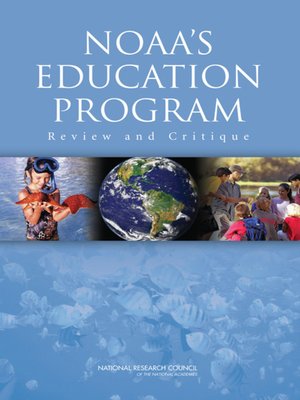
Sign up to save your library
With an OverDrive account, you can save your favorite libraries for at-a-glance information about availability. Find out more about OverDrive accounts.
Find this title in Libby, the library reading app by OverDrive.



Search for a digital library with this title
Title found at these libraries:
| Loading... |
<p>There is a national need to educate the public about the ocean, coastal resources, atmosphere and climate. The National Oceanic and Atmospheric Administration (NOAA), the agency responsible for understanding and predicting changes in the Earth's environment and conserving and managing coastal and marine resources to meet the nation's economic, social and environmental needs, has a broad mandate to engage and coordinate education initiatives on these topics. Since its creation in 1970, the NOAA has supported a variety of education projects that cover a range of topics related to the agency's scientific and stewardship mission.<br>
<br>
NOAA uses formal and informal learning environments to enhance understanding of science, technology, engineering and mathematics (STEM) and to advance environmental education. The work of this agency overlaps and compliments the missions of other federal agencies, institutions of higher education, private and nonprofit organizations. Coordination among these agencies and organizations has been challenging. Limited education resources and the inherently global nature of NOAA's mission make strategic partnerships critical in order for the agency to accomplish its goals. Additionally, clear education goals, planning, and strategic use of resources are critical aspects for effective partnerships.<br>
<br>
<em>NOAA's Education Program: Review and Critique</em> provides a summary of the national education context for NOAA's role in education which is twofold: first is to advance the environmental literacy of the nation, and second is to promote a diverse workforce in ocean, coastal, Great Lakes, atmospheric and climate sciences. The book also describes the strengths and weaknesses of the education strategic plan, the education evaluation approach of the agency and strategies for improving the evaluation process.<br></p>






